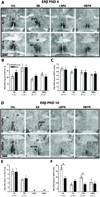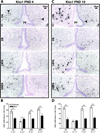Neonatal Bisphenol A exposure alters sexually dimorphic gene expression in the postnatal rat hypothalamus
- PMID: 22101008
- PMCID: PMC3273679
- DOI: 10.1016/j.neuro.2011.11.002
Neonatal Bisphenol A exposure alters sexually dimorphic gene expression in the postnatal rat hypothalamus
Abstract
Developmental exposure to Bisphenol A (BPA), a component of polycarbonate and epoxy resins, has been purported to adversely impact reproductive function in female rodents. Because neonatal life is a critical window for the sexual dimorphic organization of the hypothalamic-pituitary-gonadal (HPG) axis, interference with this process could underlie compromised adult reproductive physiology. The goal of the present study was to determine if neonatal BPA exposure interferes with sex specific gene expression of estrogen receptor alpha (ERα), ER beta (ERβ) and kisspeptin (Kiss1) in the anterior and mediobasal hypothalamus. Long Evans (LE) neonatal rats were exposed to vehicle, 10μg estradiol benzoate (EB), 50mg/kg BPA or 50μg/kg BPA by subcutaneous injection daily from postnatal day 0 (PND 0) to PND 2. Gene expression was assessed by in situ hybridization on PNDs 4 and 10. Within the anterior hypothalamus ERα expression was augmented by BPA in PND 4 females, then fell to male-typical levels by PND 10. ERβ expression was not altered by BPA on PND 4, but significantly decreased or eliminated in both sexes by PND 10. Kiss1 expression was diminished by BPA in the anterior hypothalamus, especially in females. There were no significant impacts of BPA in the mediobasal hypothalamus. Collectively, BPA effects did not mirror those of EB. The results show that neonatal hypothalamic ER and Kiss1 expression is sensitive to BPA exposure. This disruption may alter sexually dimorphic hypothalamic organization and underlie adult reproductive deficiencies. Additionally, the discordant effects of EB and BPA indicate that BPA likely disrupts hypothalamic organization by a mechanism other than simply acting as an estrogen mimic.
Copyright © 2011 Elsevier Inc. All rights reserved.
Figures






Similar articles
-
Sexually dimorphic expression of hypothalamic estrogen receptors α and β and Kiss1 in neonatal male and female rats.J Comp Neurol. 2011 Oct 15;519(15):2954-77. doi: 10.1002/cne.22648. J Comp Neurol. 2011. PMID: 21484804 Free PMC article.
-
Sex-specific Esr2 mRNA expression in the rat hypothalamus and amygdala is altered by neonatal bisphenol A exposure.Reproduction. 2014 Mar 4;147(4):537-54. doi: 10.1530/REP-13-0501. Print 2014. Reproduction. 2014. PMID: 24352099 Free PMC article.
-
Prenatal bisphenol A exposure alters sex-specific estrogen receptor expression in the neonatal rat hypothalamus and amygdala.Toxicol Sci. 2013 May;133(1):157-73. doi: 10.1093/toxsci/kft035. Epub 2013 Mar 1. Toxicol Sci. 2013. PMID: 23457122 Free PMC article.
-
Investigation of the effects of subchronic low dose oral exposure to bisphenol A (BPA) and ethinyl estradiol (EE) on estrogen receptor expression in the juvenile and adult female rat hypothalamus.Toxicol Sci. 2014 Jul;140(1):190-203. doi: 10.1093/toxsci/kfu074. Epub 2014 Apr 20. Toxicol Sci. 2014. PMID: 24752507 Free PMC article.
-
NTP Research Report on the CLARITY-BPA Core Study: A Perinatal and Chronic Extended-Dose-Range Study of Bisphenol A in Rats: Research Report 9 [Internet].Research Triangle Park (NC): National Toxicology Program; 2018 Sep. Research Triangle Park (NC): National Toxicology Program; 2018 Sep. PMID: 31305969 Free Books & Documents. Review.
Cited by
-
Sex-specific epigenetic disruption and behavioral changes following low-dose in utero bisphenol A exposure.Proc Natl Acad Sci U S A. 2013 Jun 11;110(24):9956-61. doi: 10.1073/pnas.1214056110. Epub 2013 May 28. Proc Natl Acad Sci U S A. 2013. PMID: 23716699 Free PMC article.
-
Interaction of bisphenol A (BPA) and soy phytoestrogens on sexually dimorphic sociosexual behaviors in male and female rats.Horm Behav. 2016 Aug;84:121-6. doi: 10.1016/j.yhbeh.2016.06.010. Epub 2016 Jun 30. Horm Behav. 2016. PMID: 27373758 Free PMC article.
-
Evidence for bisphenol A-induced female infertility: a review (2007-2016).Fertil Steril. 2016 Sep 15;106(4):827-56. doi: 10.1016/j.fertnstert.2016.06.027. Epub 2016 Jul 12. Fertil Steril. 2016. PMID: 27417731 Free PMC article. Review.
-
Application of Transgenic Zebrafish Models for Studying the Effects of Estrogenic Endocrine Disrupting Chemicals on Embryonic Brain Development.Front Pharmacol. 2022 Feb 11;13:718072. doi: 10.3389/fphar.2022.718072. eCollection 2022. Front Pharmacol. 2022. PMID: 35264948 Free PMC article. Review.
-
Impact of Low Dose Oral Exposure to Bisphenol A (BPA) on the Neonatal Rat Hypothalamic and Hippocampal Transcriptome: A CLARITY-BPA Consortium Study.Endocrinology. 2016 Oct;157(10):3856-3872. doi: 10.1210/en.2016-1339. Epub 2016 Aug 29. Endocrinology. 2016. PMID: 27571134 Free PMC article.
References
-
- Aihara M, Hayashi S. Induction of persistent diestrus followed by persistent estrus is indicative of delayed maturation of tonic gonadotropin-releasing systems in rats. Biol Reprod. 1989;40:96–101. - PubMed
-
- Amateau SK, Alt JJ, Stamps CL, McCarthy MM. Brain estradiol content in newborn rats: sex differences, regional heterogeneity, and possible de novo synthesis by the female telencephalon. Endocrinology. 2004;145:2906–2917. - PubMed
Publication types
MeSH terms
Substances
Grants and funding
LinkOut - more resources
Full Text Sources

